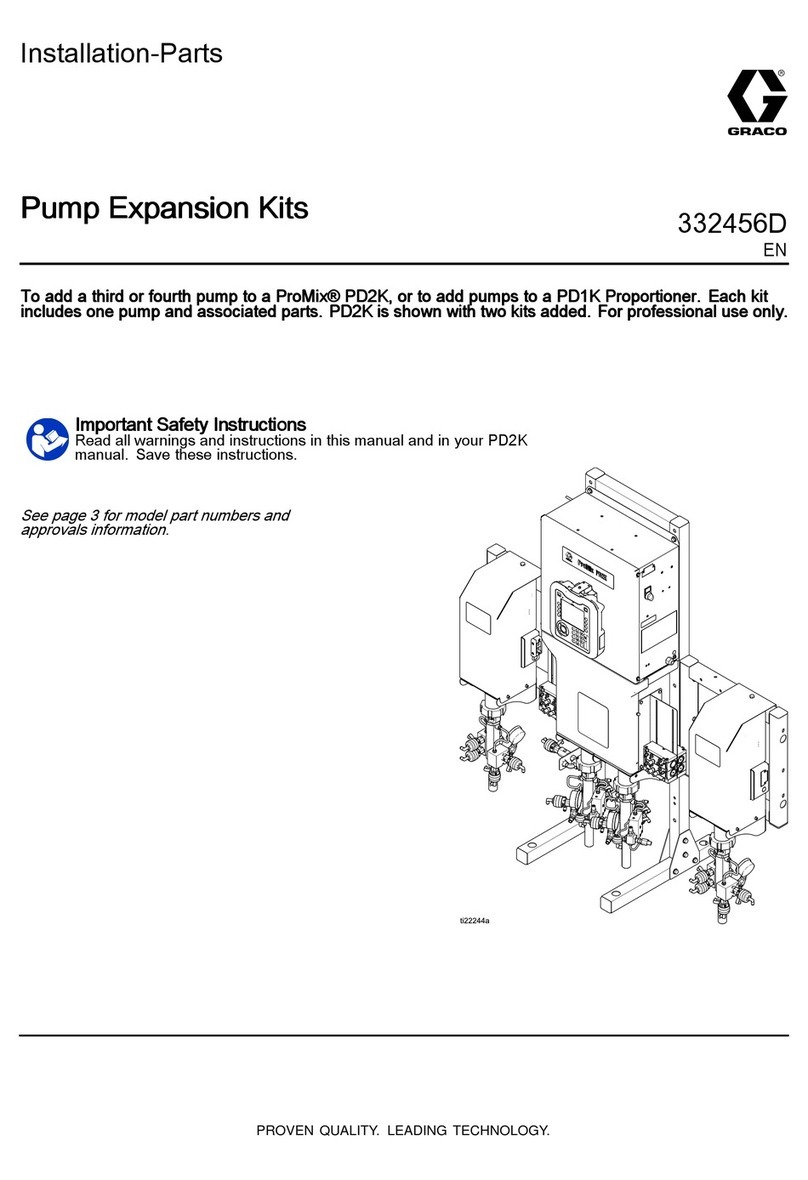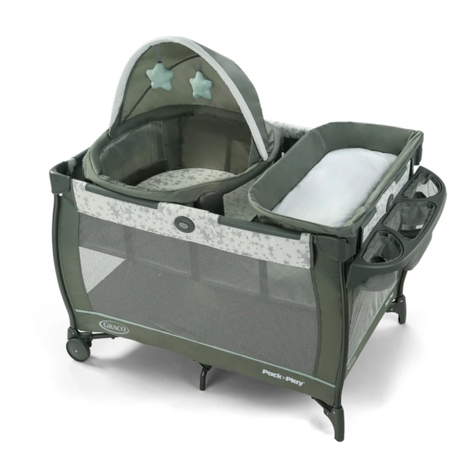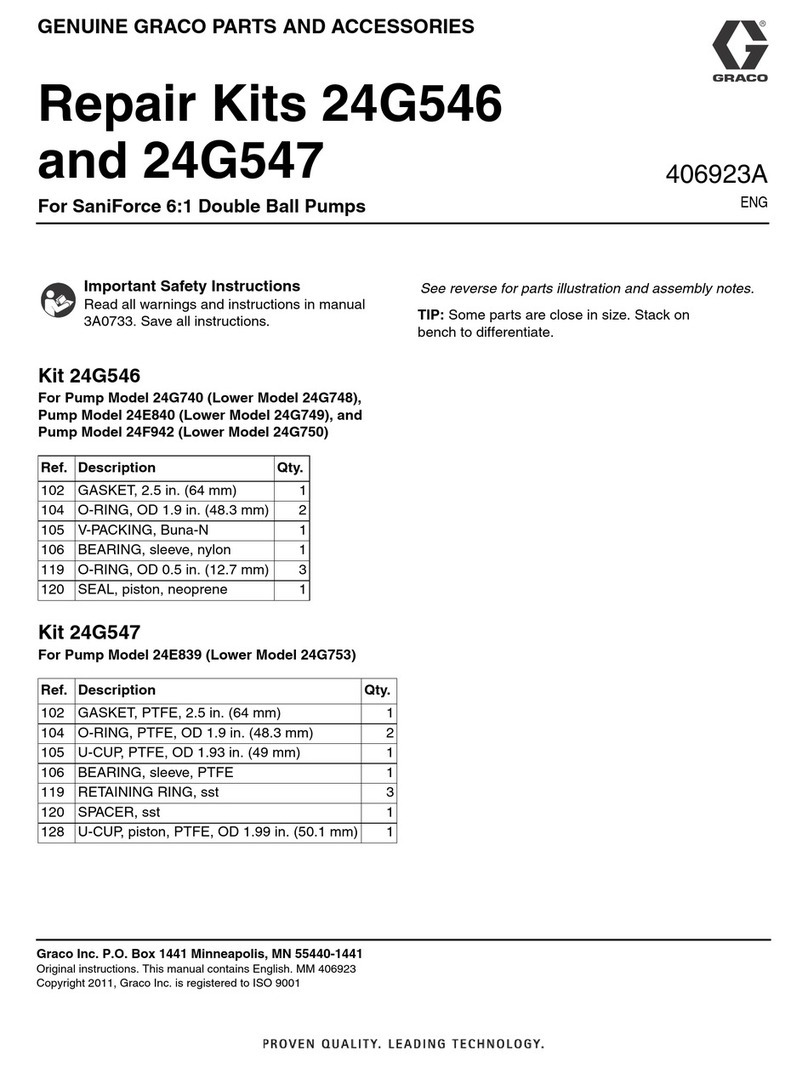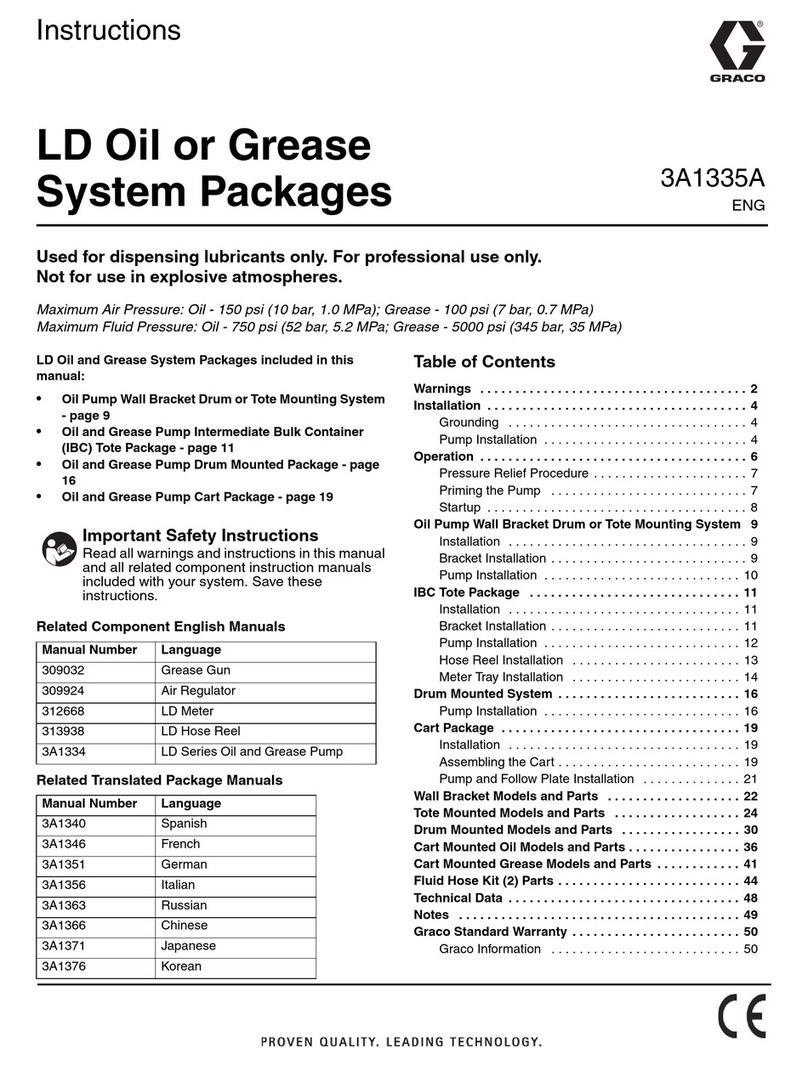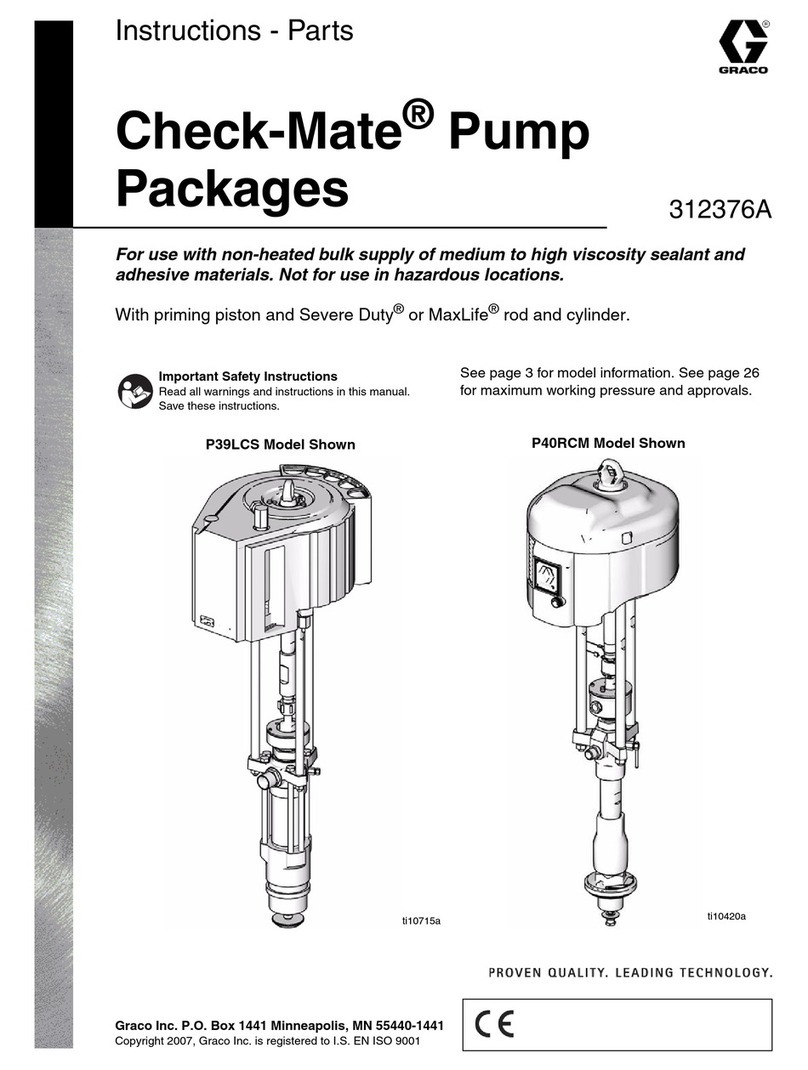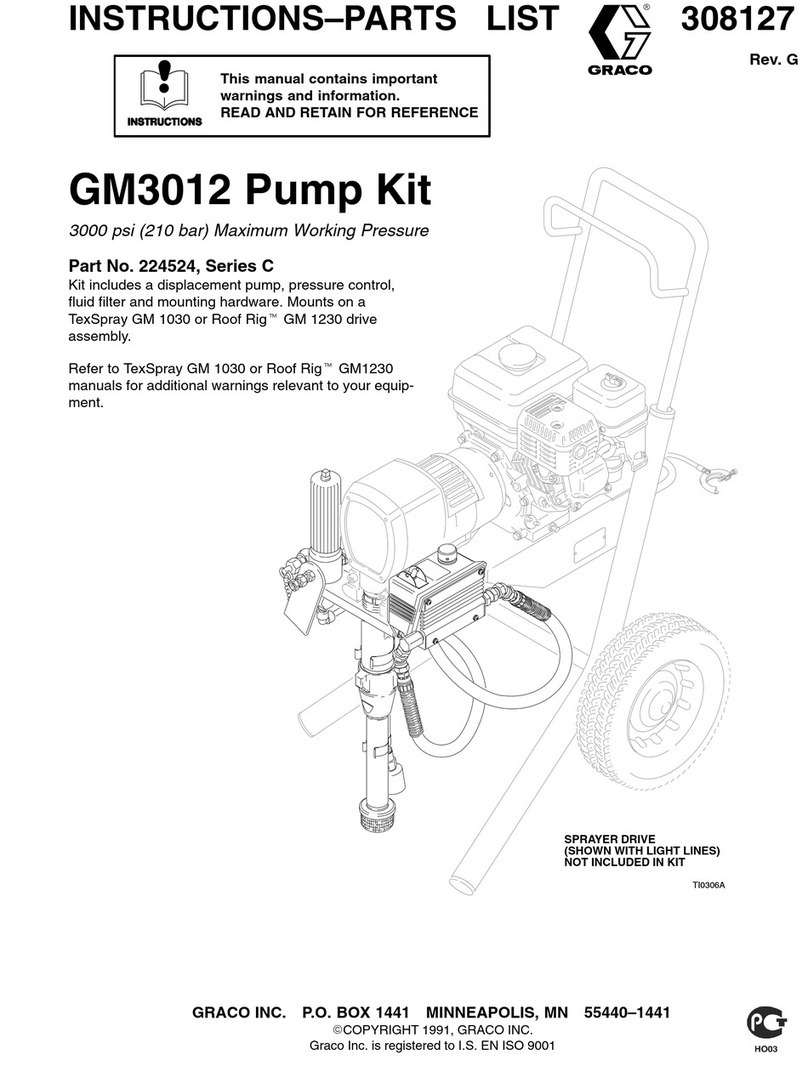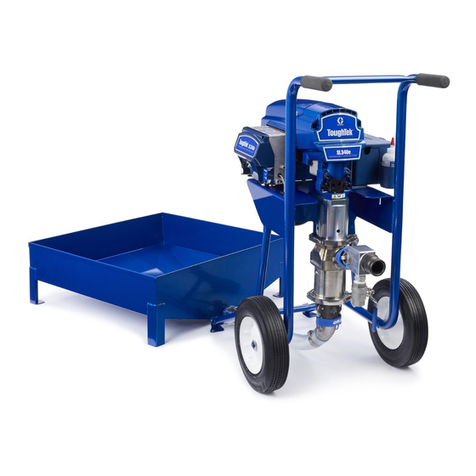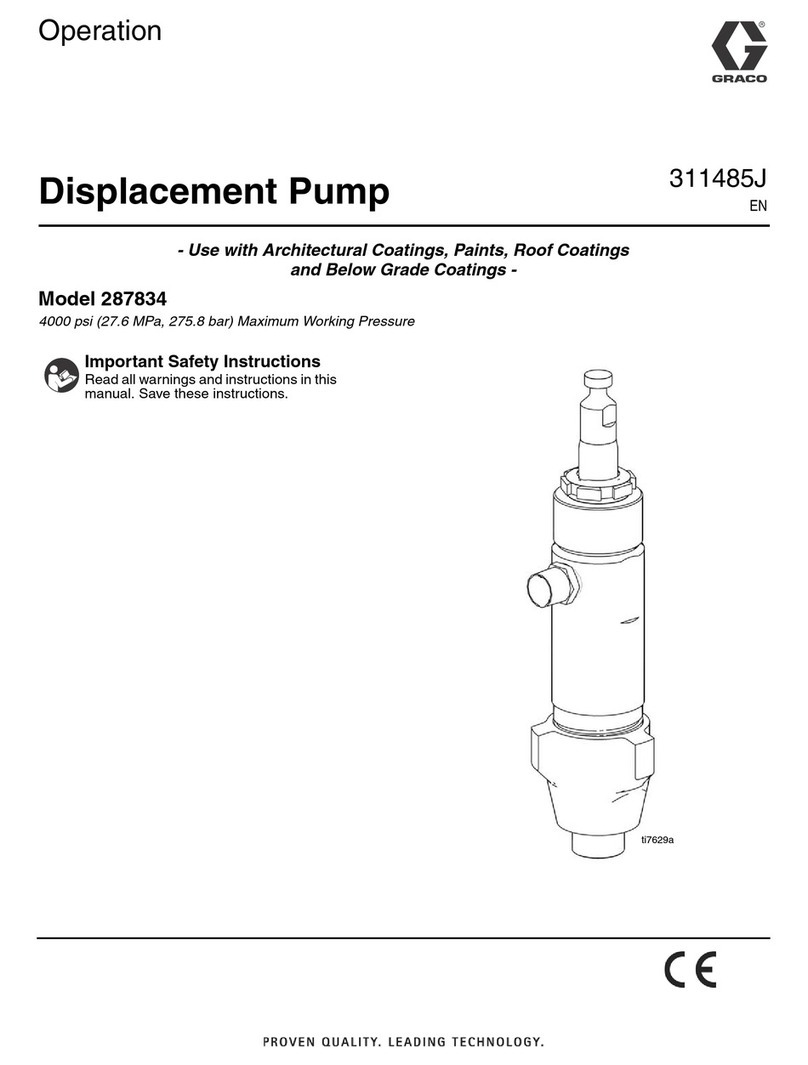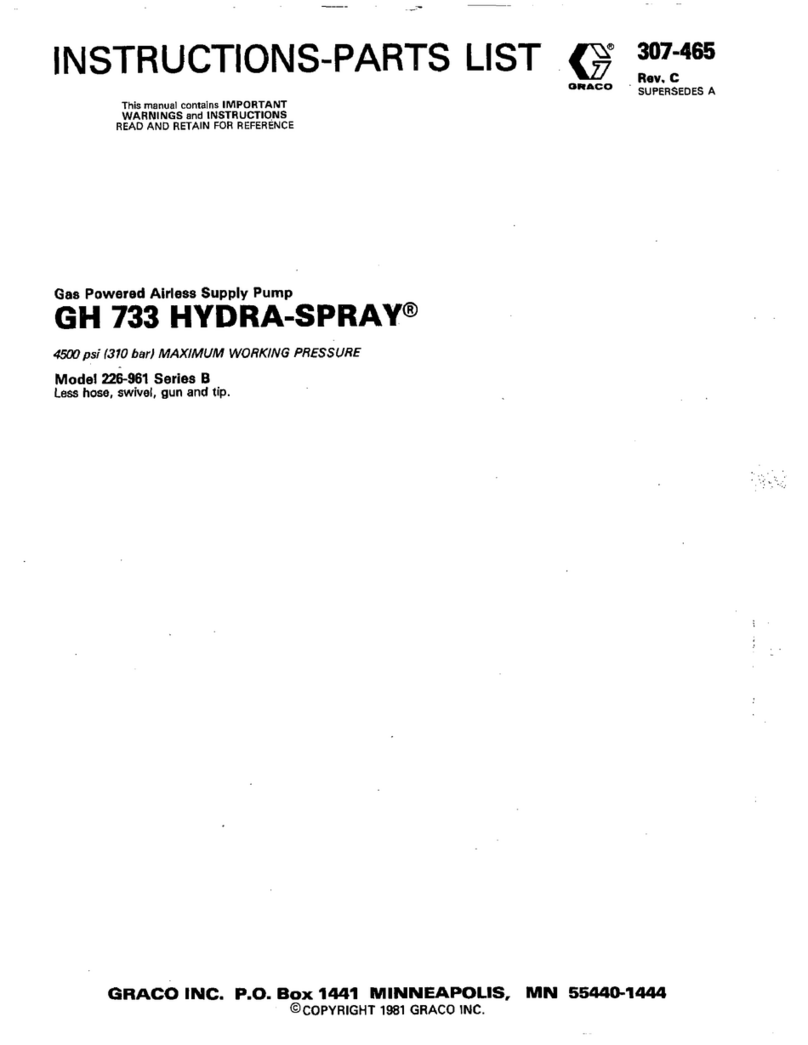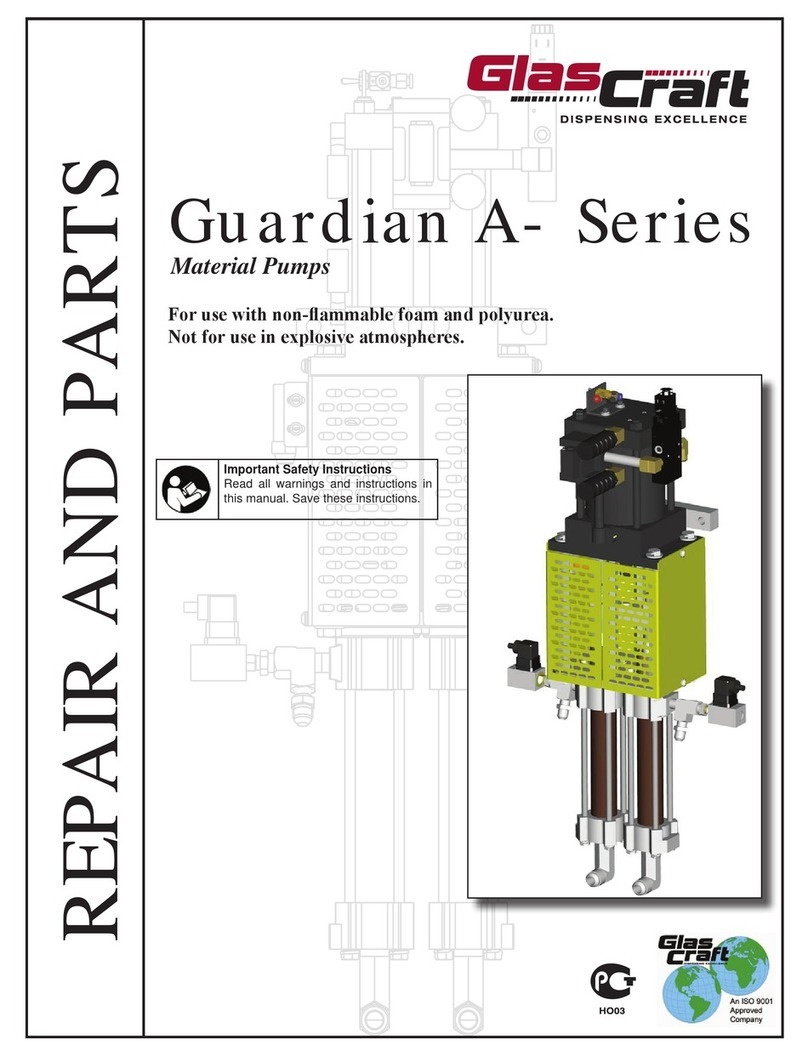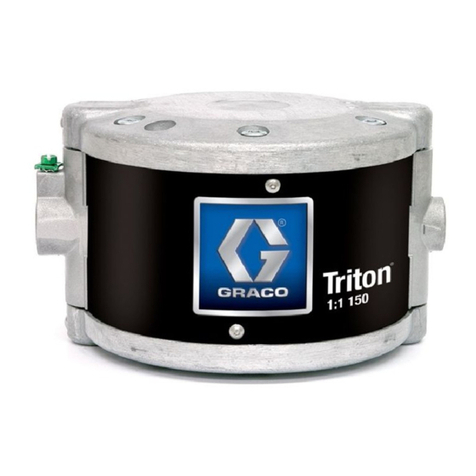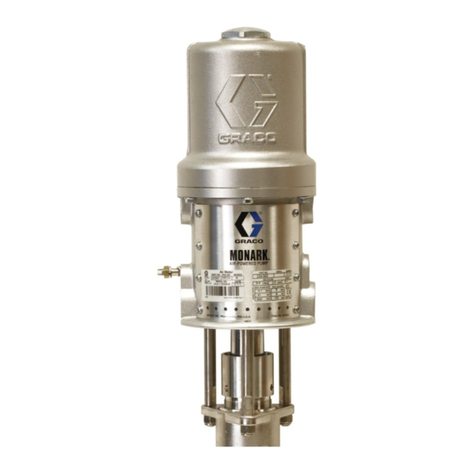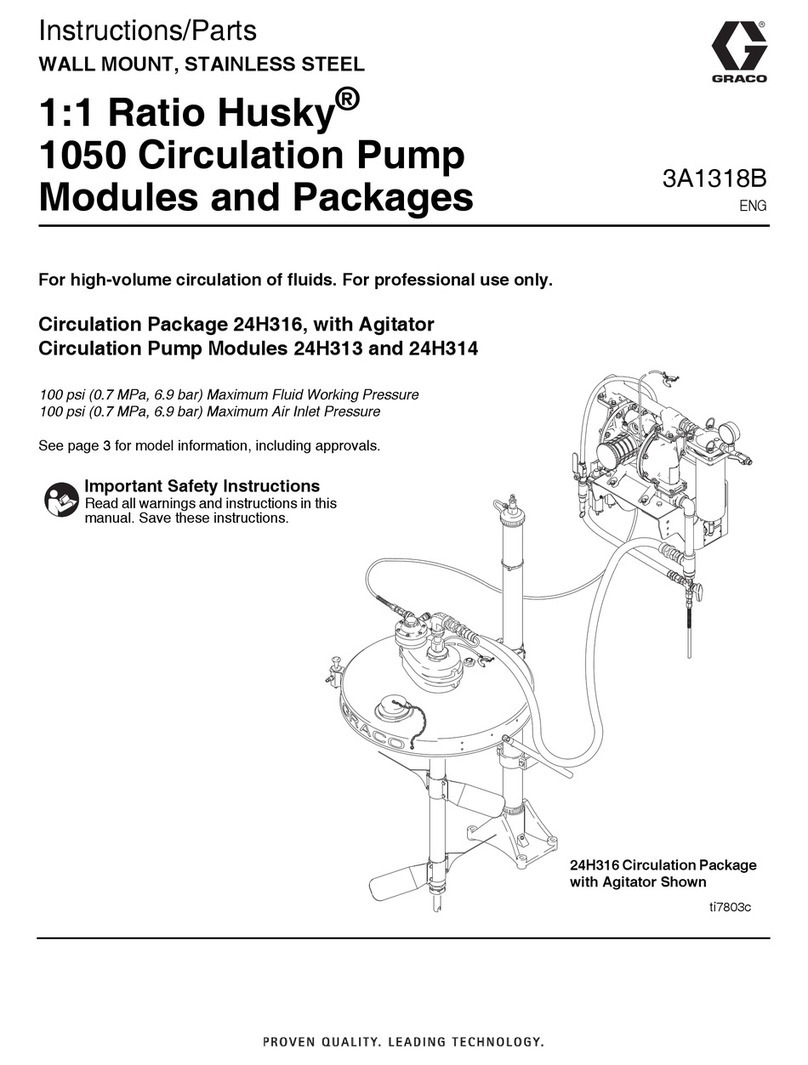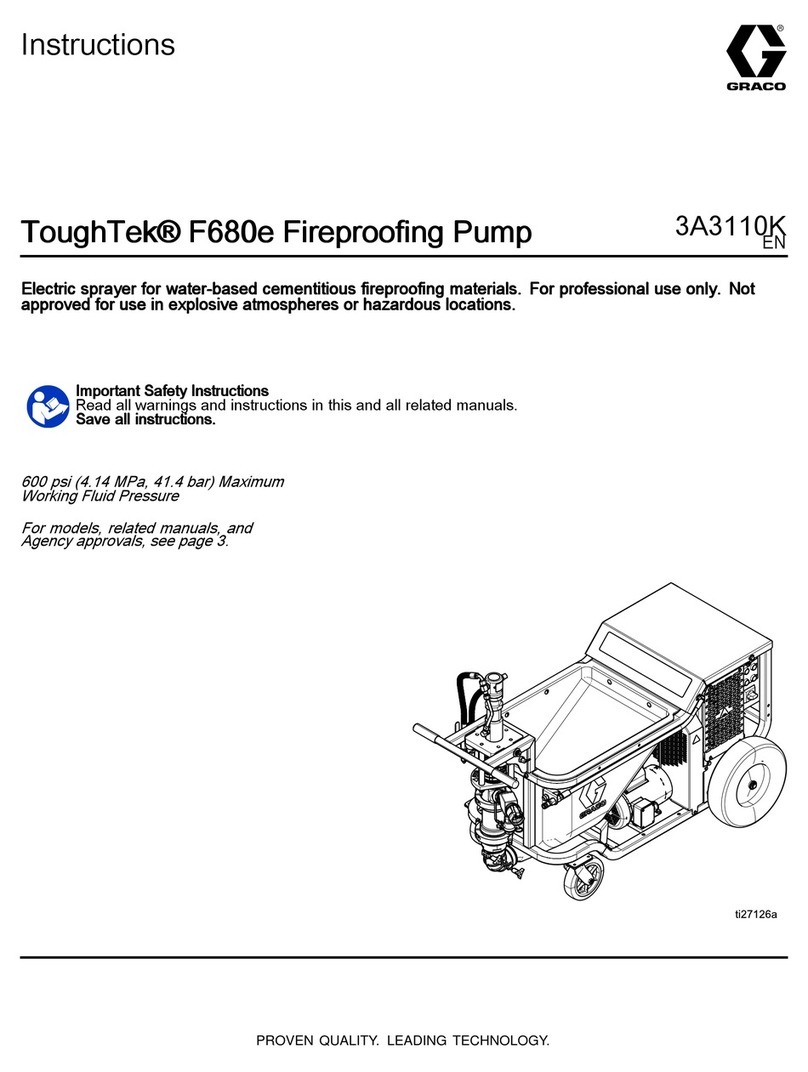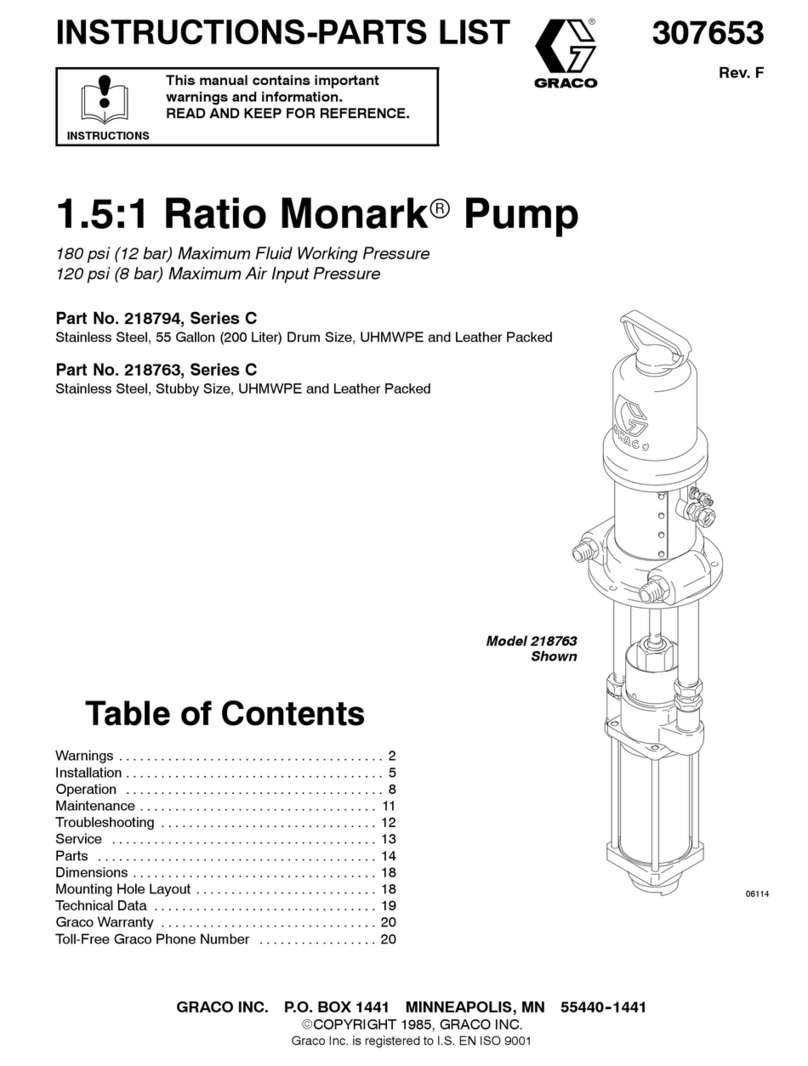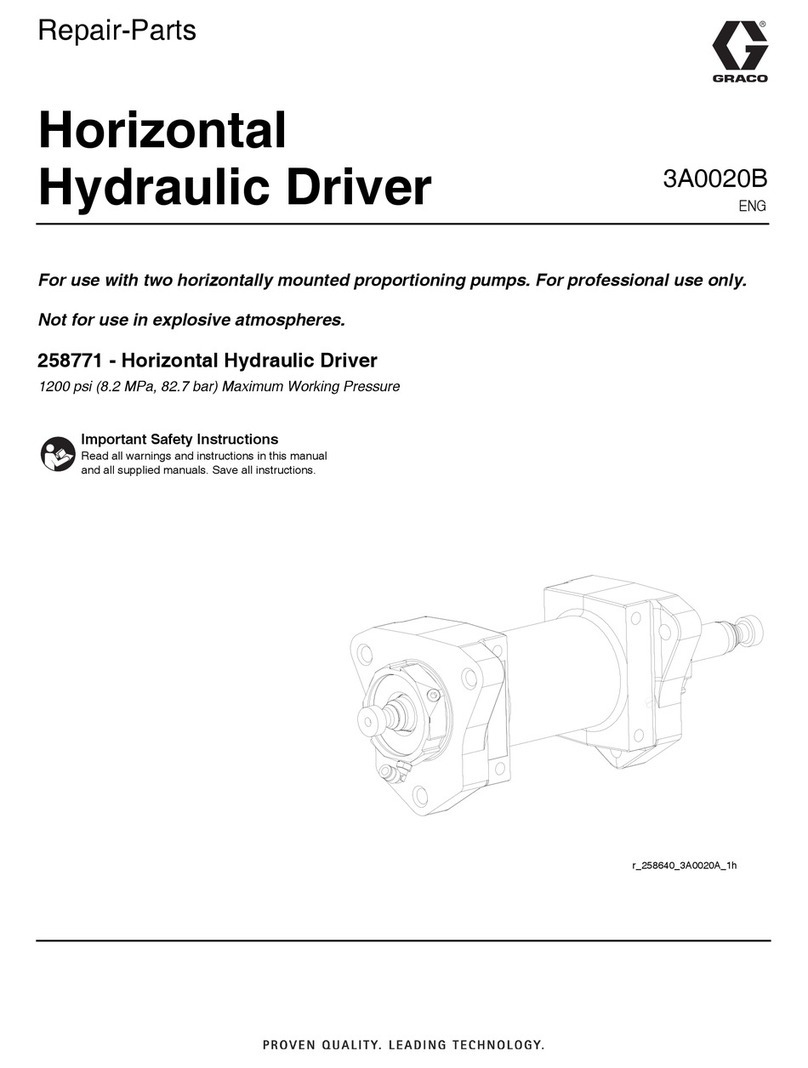
5
EQUIPMENT MISUSE HAZARD
General
Safety
Any misuse of the spray equipment or accessories, such as
overpressurizing,
modifying parts, using incompatible chemicals and flu
-
ids, or using worn or damaged parts, can cause them to rupture and result
in
fluid injection, splashing in the eyes or on the skin, or other serious bod
-
ily
injury
, or fire, explosion or property damage.
NEVER
alter or modify any part of this equipment; doing so
could cause it
to
malfunction.
CHECK
all spray equipment regularly and repair or replace worn or dam
-
aged
parts immediately
.
Always
wear protective eyewear
, gloves, clothing and
respirator as rec
-
ommended
by the fluid and solvent manufacturer
.
System
Pressure
NEVER
exceed the recommended working pressure or the maximum air
inlet pressure stated on your pump or in the TECHNICAL DATA on
pages
21–25.
Be
sure that all
spray/dispensing equipment and accessories are rated to
withstand
the maximum working pressure of the pump. DO NOT
exceed
the
maximum
working pressure of any component or accessory used in
the
system.
Fluid
Compatibility
BE
SURE that all fluids and solvents used are chemically compatible with
the
wetted parts shown in the
TECHNICAL DA
TA
on pages 21–25. Al
-
ways
read the manufacturer
’
s literature before using fluid or solvent
in
this
pump.
HOSE SAFETY
High
pressure fluid
in the hoses can be very dangerous. If the hose devel
-
ops
a leak,
split or rupture due to any kind of wear
, damage or misuse, the
high
pressure spray emitted from it can cause a fluid injection injury or
other
serious bodily injury or property damage.
ALL
FLUID HOSES USED WITH A FLEXING MOTION MUST
HA
VE
SPRING GUARDS ON BOTH ENDS!
The spring guards help protect
the
hose from kinks or bends at or close to the coupling which can result
in
hose rupture.
TIGHTEN
all fluid connections securely before each use. High pressure
fluid can dislodge a loose coupling or allow high pressure spray to be
emitted
from the coupling.
NEVER
use a damaged hose. Before each use, check the entire hose
for
cuts, leaks,
abrasion,
bulging cover
, or damage or movement of the hose
couplings.
If any of
these conditions exist, replace the hose immediately
.
DO
NOT try to recouple high pressure hose or mend it with tape or any
other
device.
A repaired hose cannot safely contain the high pressure
fluid.
HANDLE
AND ROUTE HOSES CAREFULL
Y
. Do not pull on hoses to
move
equipment. Do not use fluids which are not compatible
with the in
-
ner
tube and cover of the hose. DO NOT expose Graco hoses to tem
-
peratures
above 82
_ C
(180
_ F)
or below –40
_ C
(–40
_ F).
Hose Grounding Continuity
Proper
hose grounding continuity is essential to maintaining a grounded
spray
system. Check the electrical resistance of your air and fluid hoses
at
least once a week. If your hose does not have a tag on it which speci
-
fies the maximum electrical resistance, contact the hose supplier or
manufacturer
for the maximum resistance limits. Use a resistance meter
in
the appropriate range for your hose to check the resistance. If the
resis
-
tance
exceeds the
recommended limits, replace it immediately
. An un
-
grounded
or poorly
grounded hose can make your system hazardous.
Also,
read
FIRE OR EXPLOSION HAZARD
, below
.
FIRE OR EXPLOSION HAZARD
Static
electricity is created by the high velocity flow of fluid through the
pump and hose. If every part of the spray equipment is not properly
grounded,
sparking may occur
, and the system may become hazardous.
Sparking
may also occur when
plugging in or unplugging a power supply
cord.
Sparks can ignite fumes from solvents and the fluid being
sprayed,
dust
particles and other flammable substances, whether you are
spray
-
ing
indoors or outdoors, and can
cause a fire or explosion and serious
bodily
injury and property damage. Do not plug in or unplug any power
supply
cords in the spray area when there is any chance of igniting fumes
still
in the air
.
If
you experience any static sparking or even a slight shock while using
this
equipment,
ST
OP SPRA
YING IMMEDIA
TELY.
Check the entire sys
-
tem
for proper grounding. Do not use the system again until the problem
has
been identified and corrected.
To ground the pump:
To ground the pump, loosen the grounding lug locknut (A) and
washer
(B). Insert one end of a 1.5 mm
@
(12 ga) minimum ground
wire
(D) into the slot
in lug (C) and tighten the locknut securely
. See
Fig
1. Connect the other end of the wire to a true earth ground. See
ACCESSORIES
on page 18 to order a ground wire and clamp.
Fig
1
A
D
BC
Grounding
To reduce the risk of static sparking, ground the pump, object being
sprayed,
and all other spray equipment used or located in the spray area.
CHECK
your local electrical code for detailed grounding instructions for
your
area and type of equipment. BE SURE to ground all of this spray
equipment:
1.
Pump:
use a ground wire and clamp. See Fig 1.
2.
Air hoses:
use only grounded air hoses.
3.
Fluid hoses:
use only grounded fluid hoses.
4.
Air compressor:
follow manufacturer
’
s recommendations.
5.
Spray
gun:
grounding is obtained through connection to a properly
grounded
fluid hose and pump.
6.
Fluid supply container:
according to your local code.
7.
Object being sprayed:
according to your local code.
8.
All
solvent pails used when flushing,
according to your local
code.
Use only metal pails, which are conductive, placed on a grounded
surface.
Do not place the pail on a nonconductive
surface, such as
paper
or cardboard, which interrupts the grounding continuity
.
9.
T
o maintain grounding continuity when flushing
or relieving pres
-
sure
,
always hold a metal part of the spray gun firmly to the side of a
grounded
metal
pail, then trigger the spray gun.
Flushing
Safety
Before
flushing, be sure the
entire system and flushing pails are properly
grounded. Refer to Grounding, above. Follow the Pressure Relief
Procedure
on page 4, and remove the spray tip/nozzle from the spray
gun. Always use the lowest possible fluid pressure, and maintain firm
metal–to–metal contact between the spray gun and the pail during
flushing to reduce the risk of fluid injection injury , static sparking and
splashing.
IMPORTANT
United
States Government safety standards have been adopted under the Occupational Safety and Health Act. These standards – particularly the Gen
-
eral
Standards, Part 1910, and the Construction Standards, Part 1926 – should be consulted.


